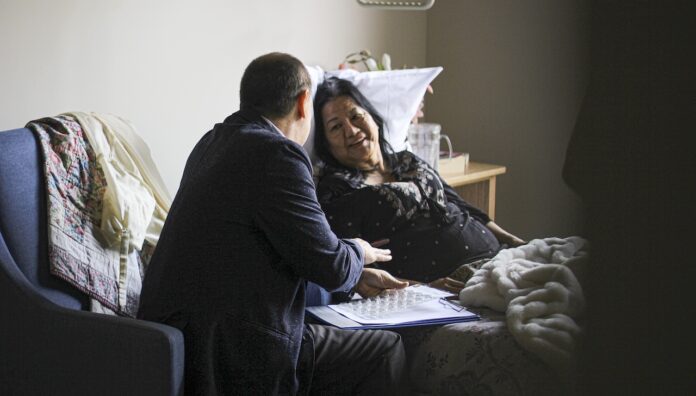Funding for on-site pharmacists in aged care heralds a new beginning for medicine safety in the sector, with pharmacists able to use their unique skills to improve the lives of some of Australia’s most vulnerable people.
The findings of the Royal Commission into Aged Care Quality and Safety were stark. In a 2,800-page report, which included 148 recommendations, commissioners Tony Pagone and Lynelle Briggs set out the ‘poor quality … and fundamental systemic flaws with the way the Australian aged care system is designed and governed.’1
It followed commission’s interim report – simply titled Neglect – which found the system ‘does not deliver uniformly safe and quality care, is unkind and uncaring towards older people and, in too many instances, it neglects them’.2
Among the problems identified were the widespread use of chemical restraint, and polypharmacy leading to sedation, falls and avoidable hospitalisations.
In a submission3 to the royal commission, PSA urged the government to embed pharmacists in aged care in order to help address these issues.
This call was heeded, and in March this year the Morrison government announced it would commit $345.7 million to improve medicine safety for aged care residents by funding all government-funded residential aged care facilities (RACFs) to engage an on-site pharmacist – a unique workforce.4
The new Labor government will honour this commitment, and the new program is scheduled to begin from 1 January 2023, following extensive stakeholder consultation – including with PSA. It will replace existing Residential Medication Management Review (RMMR) services and marks a new way of approaching medicine safety in the sector.
Australian Pharmacist spoke with pharmacists and six stakeholder groups about what to expect from this new model.
Rhyan Stanley MPS
PSA Senior Pharmacist – Policy and ACT Manager

As a member of PSA’s national policy team, Rhyan Stanley has led PSA’s involvement in advocating for and developing a new model for pharmacists in aged care.
‘The federal government first came to PSA in August last year to talk about what pharmacists in aged care could look like. We put to them a model that we believe will achieve meaningful outcomes for patients and use the skills of pharmacists. This includes recommending 0.6 full-time equivalent pharmacists per 100 residents.
‘As the peak body for pharmacists no matter where they work, PSA has long been advocating for different opportunities, including pharmacists in general practice and in Aboriginal health services. Following the final report of the royal commission, on-site pharmacists in aged care was a natural next step.
‘There were so many terrible stories that came out of the commission, like using chemical restraint to keep people lying in bed, not really functioning, because they were too hard to deal with. That’s not good enough.
‘The funding is recognition of the role pharmacists can play in improving outcomes for people in aged care. Pharmacists are medicines experts and being on-site means they can ensure medicines are used as best they can be. This will have huge flow-on effects for patients, making sure they are happy, comfortable and safe.
‘We don’t have all the details yet, but there are some key principles we believe are important. We want a model that’s flexible – there is no one-size-fits-all solution that will work for every facility. But there also needs to be structures in place so that a patient can expect a similar outcome no matter where they are.’
Maria Berbecaru MPS
Accredited Pharmacist, Consultant Pharmacy Services, Tasmania

Just 3 years out of university, in 2019 Maria Berbecaru made history by implementing Australia’s first integrated community pharmacy-delivered medicine supply and on-site clinical service model at an RACF.
‘Hearing that the government would provide funding for on-site pharmacists in RACFs was so exciting. A lot of hard work has been invested by researchers, the PSA, accredited pharmacists and others to shine a light on this important but neglected area of practice, and it brings me great joy to see it gaining the attention it deserves.
‘The funding should be seen as a collective win for the pharmacy profession, RACFs, residents and Australia’s health system overall. But while funding – and its allocation – is important, there also needs to be a strong and well-equipped pharmacist workforce to ensure the new model’s longevity. It’s crucial pharmacists undergo training to ensure they deliver the services confidently, appropriately and to a high standard.
‘Having an integrated medication supply and embedded residential clinical pharmacist service allows pharmacists to identify medication-related problems and intervene in real time, as well as closely monitor outcomes of implemented medication recommendations.’
Kieran Baker MPS
Principal pharmacist, Priceline Pharmacy Birkenhead Point, NSW

Community pharmacist and owner Kieran Baker supplies DAAs and medicines to multiple RACFs.
‘I’ve been involved in the aged care sector for the past decade. From the start, I saw a sector that is in need but is appreciative of what we do and how we can assist. I see huge potential for pharmacists to add value to aged care.
‘My day-to-day ranges from DAA preparation to drug chart interpretation/reconciliation, clinical consulting and reporting, logistics and workforce management as well as constant problem solving.
‘There’s a lot of unpaid work, a lot of after-hours work and many pharmacy staff needed to deliver a great product. Lately this has involved COVID-19 and flu outbreak management, with long hours to ensure medication management principles are put in place and consistently practised at RACFs.
‘There are already pharmacists in aged care in the form of a supply pharmacy and a consultant pharmacist, but I think a key driver from our peak pharmacy bodies is a greater scope of practice. Overseas this includes prescribing and deprescribing within our capacity, ordering and interpreting pathology tests and an expanded range of vaccinations and primary care services.
‘An on-site pharmacist with an expanded scope of practice could deprescribe antipsychotics, prevent the unnecessary use of antimicrobials and closely monitor medication management. These are three of the key points that the royal commission recommended. From here, the other focuses should be on polypharmacy and prescribing cascades, overuse of pain medication and of course infection control.’
Patrick Reid MPS

Chairman, Illawarra Health and Medical Research Institute and CEO, IRT Group
The immediate past president of LASA, Patrick Reid is also a community pharmacist and pharmacy owner and former Chairman of the Australian Government’s Aged Care Workforce Advisory Group.
‘I’ve been lobbying pretty hard for a long time as both a pharmacist and the CEO of a large aged-care provider for pharmacists to have an extended role within aged care. We [IRT] were one of the first providers to have a pharmacist on staff, and we’ve seen the many benefits.
‘This includes the quality use of medicines aspect, particularly deprescribing. On-site pharmacists can also improve coordination with local health services such as GPs. Many GPs in regional areas have a huge workload, so having someone they can get trusted advice from quickly is incredibly useful.
‘In terms of the new model, I think the providers should have control over integrating the service in a meaningful way. In the past, it has been the tail wagging the dog. In the RMMR process we were the recipients of a service, but we had very little control over how that service was funded, delivered and how it manifested itself on the ground.
‘There are 2,500-plus providers in the country, and they operate in different ways. So, you need to find the right pharmacist for that service, and then how best to integrate them to get the best result for residents, staff and other allied health.
‘To work in this industry you need empathy. Not everybody is suited to working with this cohort, but it is very enriching. I would suggest pharmacists who haven’t considered it as a career choice to think about it, because it is quite rewarding.’
Marea O’Donnell MPS
Chief Clinical Pharmacist, Mederev

An accredited pharmacist, Marea O’Donnell has been consulting in aged care since 2018.
‘As a pharmacist who cares about people, I believe any extra involvement of pharmacists in aged care is fantastic. But putting my work hat on, we are desperate to know the details of how the funding will be rolled out.
‘I think the challenge will be providing the pharmacists. We need to think about how we’re going to get the right people with the right skills. I look for pharmacists who, at the heart of it all, want to help.
‘Pharmacists are well-trained to deal with lots of different stakeholders. We can talk to a GP in their language about medicines, but equally we can talk to a resident and their family. Those are very different conversations.
‘We constantly get asked questions about medication storage, about S8s, S4Ds and S4Rs and what the regulations are. The poor nursing staff can’t keep up, that’s why you really need a specialist.
‘I did a case conference recently with a GP, nurse practitioner and a clinical manager at an RACF. Of course, they all got paid to be there, and I didn’t, but we had a great outcome. We were able to get to the bottom of why a resident was on a lot of medicines for her heart.
‘We came up with a plan to cut back some of the unnecessary medicines and review her antipsychotics. The resident felt a lot better, her next of kin had more information and the nurse practitioner and GP had a plan to follow to improve her medication regimen.
‘She had been hospitalised a lot due to falls, and that has now decreased significantly. A simple thing like keeping a resident from falling, and keeping them out of hospital, will really improve their quality of life.’
Response from RACFs

Sean Rooney, CEO, Leading Age Services Australia (LASA)
‘The Australian Aged Care Collaboration welcomes the decision to embed pharmacists in aged care homes. It comes after successful trials of pharmacists placed in-house at aged care homes where they are able to conduct RMMRs.
‘It recognises recommendations by the Royal Commission into Aged Care Quality and Safety for pharmacist medication reviews of residents on entry to an aged care home and then annually. However, it is not clear what the governance structure will look like, and we would like the government to provide clarity on this as soon as possible.
‘Having access to on-site advice on medications provides additional support and advice to the clinical team in an aged care facility. Currently, medication reviews are being funded under the 7th Community Pharmacy Agreement. LASA is of the view that on-site accredited pharmacists delivering RMMRs should have access to Medicare items. We also support training as part of the on-site pharmacist program, which would address the current shortage of accredited pharmacists available to conduct RMMRs into the future.’
Bupa Aged Care spokesperson
‘We look forward to learning more about this program. Medication management within aged care homes is critically important to the health and wellbeing of all our residents.
‘We currently have a team of health professionals in each home – including registered nurses – who follow strict protocols when administering medications to our residents, in line with their approved health care plan. Our teams will also consult with GPs on any changes in our residents’ condition which may require a differing or new medication.’
Profession is excited
AP created a poll online to gauge professional interest in moving to an aged care career speciality.
‘What a great initiative, another diverse pharmacy-based career,’ commented Marlene Lim.
Janelle Dockray added: ‘Growth of the profession! Yes!’ She felt strongly that ‘introducing these kinds of alternative career paths ‘that pharmacists can pursue in addition to their community pharmacy work is the only way we will retain our pharmacy workforce’. While remuneration is important, ‘it’s not as important as career progression, and satisfaction’, she says. ‘Force people to stay in community with little to no prospects of role expansion or ownership opportunities and they will leave.’
 References
References
- Royal commission into aged care quality and safety. Final report: care, dignity and respect. 2021. At: https://agedcare.royalcommission.gov.au/
- Royal commission into aged care quality and safety. Interim report: neglect. 2019. At: https://agedcare.royalcommission.gov.au/publications/interim-report
- Pharmaceutical Society of Australila. Submission to the royal commission into aged care quality and safety. 2019. At: https://my.psa.org.au/s/article/Aged-Care-Quality-and-Safety
- Ministers. Department of Health. Media Release. On-site pharmacists to improve medication management in RACFs. 2022. At: www.health.gov.au/ministers/the-hon-greg-hunt-mp/media/on-site-pharmacists-to-improve-medication-management-in-racfs



 Dr Peter Tenni[/caption]
Dr Peter Tenni[/caption]
 How should we deprescribe gabapentinoids, according to the Maudsley Deprescribing Guidelines[/caption]
How should we deprescribe gabapentinoids, according to the Maudsley Deprescribing Guidelines[/caption]



 Pharmacists have always prescribed, but they have the potential to prescribe much more
Pharmacists have always prescribed, but they have the potential to prescribe much more





